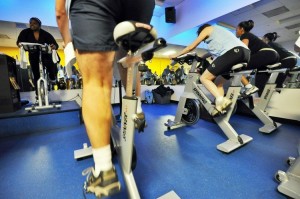
Tall men, especially if they are obese, are at a greater risk for blood clots than shorter, normal-weight men, suggests a new study. (AFP / Getty Images / April 29, 2011)
Tall and obese men appear more likely to develop venous thromboemoblism, which can lead to a potentially lethal blood clot in the lungs, according to a study published Thursday.
Researchers from the University of Tromso in Norway analyzed height and weight data from 26,714 people and assessed the incidence of venous thromboembolism over 12-1/2 years. In that time, 461 people developed the condition, in which a blood clot (or thrombosis) forms in a deep vein, usually in the thigh, and can move into an artery in the lung. Here’s a basic explanation of the condition fromPatient Health International and a detailed look, including risk factors, from Cleveland Clinic.
In the lung, the clot (called a pulmonary embolism) blocks blood supply and can lead to death. The American Heart Assn. offers this look at venous thromboembolism incidence and fatality statistics.
It begins: “Venous thromboembolism occurs for the first time in about 100 per 100,000 persons each year in the United States. About one third of patients with symptomatic VTE manifest pulmonary embolism, whereas two thirds manifest deep-vein thrombosis alone.”
The new research suggests that being either obese or tall, or the combination, puts men at greater risk for the condition compared to short (5 feet 7.7 inches or shorter), normal-weight men. Men who were obese and taller than 5 feet 11.7 inches were at fivefold greater risk of a blood clot, and men who were tall but of normal weight had a 2.6 times greater risk. Short, obese men had a 2.1 greater risk than short normal-weight men for a blood clot.
Yes, women too: Obese women, short or tall, had a slightly greater risk of a blood clot, scientists reported in Arteriosclerosis, Thrombosis, and Vascular Biology. Tall normal-weight women didn’t have increased risk.
Obesity is already a well-known risk factor for deep-vein thrombosis, but researchers aren’t sure why tall people would be more prone to such clots. The lead author of the study, Sigrid Braekkan, offers an explanation in a press release:
“In tall people the blood must be pumped a longer distance by the calf-muscle pump, which may cause reduced flow in the legs and thereby raise the risk of clotting,” Braekkan said.
There’s nothing a man can do about his height, so researchers say big men – and short ones, of course — should try to stay slim.
In the meantime, here are a few tips for preventing blood clots from the Agency of Healthcare Research and Quality:
— Don’t remain sedentary for more than an hour.
— On plane trips, get up from your seat and move around.
— Try not to cross your legs
— Wear loose-fitting clothing
— Reduce salt in your diet
And here are some tips from the same agency on preventing venous thromboembolsim in the hospital. There, it’s the most common cause of preventable death.









